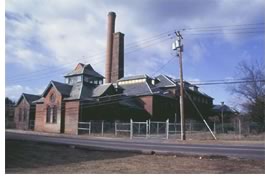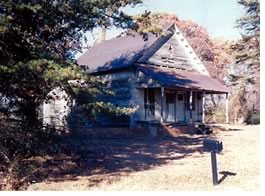
Projects also to be featured in July 6 History Channel documentary
and Atlantic Monthly
Earlier this month, the National Trust for Historic Preservation released its "11 Most Endangered Historic Places" list, which identifies projects—built and natural—threatened by neglect, insufficient funds, inappropriate development, or insensitive public policy. The projects range from ancient Indian burial grounds in the West to the skipjack fleet on the Chesapeake Bay.
The National Trust reports that the listing does not ensure protection of a site or guarantee funding. However "the designation has been a powerful tool for raising awareness and rallying resources to save threatened sites in every region of the country."
In addition, the History Channel will offer a one-hour documentary program, "America's Most Endangered" on the projects on Saturday, July 6, at 10 p.m. EDT/PDT. The show is part of the Save Our History campaign, the History Channel's award-winning national initiative dedicated to historic preservation and history education. Additionally, The Atlantic Monthly magazine will present a special feature insert, sponsored by Shell Oil Company, in its July/August issue.
The 11 Most Endangered Sites this year are:

1. Kw'st'an Sacred
Sites at Indian Pass, Imperial County, Calif.
At Indian Pass near the lower Colorado River in Imperial County, Calif.,
Native Americans from the Quechan Tribe have come for thousands of years
on spiritual pilgrimages to assist their dead in a journey to the next
world. Throughout millennia, they have left pottery shards, petroglyphs,
and ancient rock sculptures. This land of sheer beauty, currently managed
by the Federal Bureau of Land Management, could soon be desecrated, the
National Trust reports. Glamis, a gold mining corporation, wants to dig
a 1,600-acre gold mine at Indian Pass—with three open pits up to
880 feet deep and a 300-foot-tall cyanide heap leach pile—to mine
ore of such low grade that only one ounce of gold would be mined for every
422 tons of waste rock removed, according to the National Trust. Former
Interior Secretary Babbitt refused to issue a permit for the mine. The
Bush Administration, however, has reversed the ruling. Interior Secretary
Norton has the authority to deny permission for the mine, the National
Trust says.
 2.
St. Elizabeths Hospital, Washington, D.C.
2.
St. Elizabeths Hospital, Washington, D.C.
St. Elizabeths Hospital, an 1850s 300-acre National Historic Landmark
complex, at one time included a railroad, bakery, and greenhouse and an
impressive collection of Victorian and Colonial Revival buildings. Thomas
U. Walter, the architect of the U.S. Capitol dome, designed its Center
Building, in the 1850s. Used as an infirmary for Civil War soldiers, St.
E's played a critical role in the development of modern psychotherapy
technique. The Center Building now has suffered serious water damage and
brick erosion, and several Victorian buildings are in need of roofing
and brick repairs. This deterioration plus a shrinking patient population
has left many historically significant structures vacant, which, with
no plan for the adaptive reuse of the buildings, has sparked pressure
to develop the property.
An Urban Land Institute panel sponsored by the District of Columbia and the U.S. General Services Administration was recently convened to begin planning for St. Elizabeths. In addition, according to the National Trust, a public-private partnership can help mitigate the threat to the hospital and potentially save the property through adaptive reuse. The former Pennsylvania Avenue Development Corporation, which reclaimed Washington's core from decay, is a model that could be followed.

3. Historic Bridges
of Indiana—Carroll County
Indiana contains more than 80 historic bridges listed either in the Indiana
State Register of Historic Places or the National Register. From 1987
to 1999, the National Trust reports, poor planning and conflicting interests
led to the loss of 62 percent of Indiana's metal bridges built between
1860 and 1930. Most of the historic bridges are threatened by county governments'
drive to replace them with modern structures at the recommendation of
consulting engineers, even though replacement typically costs taxpayers
much more than restoration. The National Trust believes that Indiana needs
a comprehensive state bridge preservation plan that sets clear priorities
for preservation, with funding to allow for rehabilitation. The National
Trust also recommends that preservation advocates must be consulted as
individual bridge projects are considered.
 4.
Chesapeake Bay Skipjack Fleet, Maryland
4.
Chesapeake Bay Skipjack Fleet, Maryland
Once numbering nearly 1,000, the wooden skipjack boats used along the
Chesapeake Bay for oyster dredging have dwindled to a dozen skipjacks
still in commercial use as the bay's oyster population plummeted. Constructed
between 1886 and 1956, boats in the remaining fleet are severely deteriorated
and threatened by the elements, deferred maintenance, and the difficulty
and expense of obtaining appropriate materials for repair and restoration.
In 1988, 35 vessels remained. Today there are only about a dozen. In 1999,
a task force was appointed by Maryland's governor to investigate issues
that must be addressed to save the boats, including funding assistance
for maintenance, affordable liability and hull insurance, land use and
zoning measures to support the maritime industry, and alternative but
compatible uses for the commercial vessels. The task force has also considered
establishing an educational program to encourage and teach traditional
Bay trades and a program where skipjacks are linked to state tourism.
 5.
Guthrie Theater, Minneapolis
5.
Guthrie Theater, Minneapolis
The Guthrie Theater, designed by prominent Minnesota architect Ralph Rapson,
opened in 1963. For nearly 40 years, the Guthrie has been the home of
the celebrated Guthrie Theater Company and has played host to a "who's
who" of visiting concert performers. The Walker Art Center, which
owns the Guthrie, intends to demolish the theater and replace it with
a sculpture garden if they can raise the required funds (they currently
are at the halfway mark). Even in the face of Governor Ventura's recent
veto for state funds to support the new theatre, the Guthrie Theater Company
is already well on its way to achieving their financial goals. In November
2001, the Minneapolis City Council approved a building permit that would
allow the Guthrie to be razed. The National Trust says that renowned architects,
performers, and local citizens have joined together to find alternatives
to demolition—including uses to take advantage of its superb acoustics.
 6.
Pompey's Pillar, Yellowstone County, Montana
6.
Pompey's Pillar, Yellowstone County, Montana
The 100-foot-tall Pompey's Pillar bears the only physical evidence of
the remarkable 8,000-mile expedition of Lewis and Clark. Here, William
Clark carved his name and the date—July 25, 1806.
United Harvest Corporation, a grain-exporting conglomerate, is now planning to erect a 100-acre grain-loading trucking and railroad terminal with four 150-foot-tall grain elevators within three-quarters of a mile of Pompey's Pillar. In addition to the visual impact of grain elevators, dust, noise, and heavy traffic are all guaranteed to have a major detrimental impact on the serenity and historic character of the National Monument. Additionally, United Harvest began construction without securing the proper state permit or conducting a study to determine the impact of the grain facility on the surrounding areas, according to the National Trust. The Trust further reports that the only way to mitigate serious impact to the integrity of Pompey's Pillar National Historic Landmark is to relocate the grain facility to another location. Local preservationists have proposed three alternative sites to United Harvest. But, so far, negotiations regarding an alternative are at a stalemate.
7. Missouri River
Cultural and Sacred Sites in Montana, North Dakota, and South Dakota
The upper Missouri River basin has been home to Native American tribes
since the last ice age 12,500 years ago. The Missouri River valley includes
thousands of archeologically important places representing Native-American
heritage that extend to the present day. The area's cultural resources
and sacred sites are routinely looted, and the fluctuating water levels
of the lakes created by the Missouri River's six reservoir and dam projects
constantly erode the shoreline, causing the loss of scores of archeological
sites, and even human remains, every year.

The Trust says that although the U.S. Army Corps of Engineers is responsible for overall management of the dams, the Corps continues to ignore federal laws that require the Corps to take responsibility for protecting these resources from damage. The tribes of the Missouri River Valley are asking the federal government to obey the law. The plan that governs management of the river, the Missouri River Master Water Control Plan, does not adequately address environmental and cultural resources, and the National Trust believes that the plan must be expanded or supplemented by additional guidelines that would mandate compliance with all federal laws.
 8.
Hackensack Water Works, Hackensack, N.J.
8.
Hackensack Water Works, Hackensack, N.J.
Built on an artificial island in the Hackensack River, this water works
began in 1882 as a pumping station for northern New Jersey. The machinery,
intact and spanning a period more than 100 years, documents key developments
of the Industrial Revolution, particularly the evolution from steam to
electricity. The plant is listed in the National Register of Historic
Places and the New Jersey Register of Historic Places and is a National
Trust's Save America's Treasures project. The Hackensack Water Company
closed the site in 1990, and it soon became the property of Bergen County.
In 2001, the county requested permission from the state to demolish the
vast majority of the Water Works complex and convert a few remaining fragments
of the buildings into a proposed "ruin." A coalition of organizations
advocated to retain the complex with an appropriate adaptive reuse. A
nonprofit group, the Water Works Conservancy, has developed a preservation
and restoration proposal that includes plans for a museum, education center,
environmental center, Hackensack River research center, and cultural wing.
The future of this site currently lies in the hands of the State of New
Jersey officials, specifically the Department of Environmental Protection.
 9.
Gold Dome Bank, Oklahoma City
9.
Gold Dome Bank, Oklahoma City
An icon in Oklahoma City, the 150-foot-diameter Gold Dome Bank was constructed
in 1958, an early example of the geodesic dome patented by Buckminster
Fuller. According to the National Trust, Bank One has petitioned the city
for a demolition permit, stating that the dome needs $1.7 million in repairs
to bring it up to code. Supporters agree that the structure needs repairs
but claim that the damage is the result of deferred maintenance. The "Citizens
for the Golden Dome" group continues to stage weekly protests on
site, raises funds for preservation, sponsors
a Web site, and has obtained nearly 4,000 signatures on a save-the-dome
petition. The National Trust recommends that Bank One and local preservationists
work with potential buyers to ensure that sensitive adaptive reuse plans
are considered.
 10.
Rosenwald Schools—the South
10.
Rosenwald Schools—the South
In 1913, Julius Rosenfeld, CEO of Sears, Roebuck and Company, teamed with
Booker T. Washington, the country's preeminent African-American educator,
to improve education for African-Americans in the South. Over the next
20 years, the Rosenwald Fund instituted a system of matching grants to
help construct more than 5,300 school buildings in 15 southern and southwestern
states, using state-of-the-art plans drawn by professors at Washington's
Tuskegee Institute in Alabama. While many of the Rosenwald schools were
destroyed or abandoned, most of the remaining schools, now 75 to 85 years
old, are located in rural areas lacking funds for upkeep. There are historic
records of the schools, but limited information about their current status
and a network to save them. As first steps, the National Trust recommends
that the Rosenwald schools surveys be inventoried, examples of adaptive
reuse be shared with communities, and stronger activist networks created.
11. Teardowns in
Historic Neighborhoods
Across the nation a "teardown epidemic" is wiping out historic
neighborhoods as older houses are demolished to be replaced by dramatically
larger, out-of-scale new structures. The National Trust says the challenge
is to manage new investment to respect the character and distinctiveness
that made these neighborhoods so desirable in the first place.
 The
National Trust has documented more than 100 communities in 20 states with
significant numbers of teardowns and reports that the number is climbing
fast. A few examples:
The
National Trust has documented more than 100 communities in 20 states with
significant numbers of teardowns and reports that the number is climbing
fast. A few examples:
• From 1995 to 2000, the number of demolitions increased 45 percent
in Bergen County, N.J.
• Just outside of downtown Dallas, more than 1,000 historic early
20th century houses have been purchased, bulldozed, and sent to the dump.
• In Rancho Mirage, Calif., a museum-quality, 5,000-square-foot home
designed in 1962 by famed architect Richard Neutra was demolished without
warning.
The Trust reminds us that communities have a variety of planning and preservation tools to slow teardowns, from designating historic districts to financial incentives for residents and builders.
Copyright 2002 The American Institute of Architects. All rights reserved.
![]()
|
Please take a look at these projects in detail on the National Trust's Web site, www.nthp.org, and pass the link along. |
|